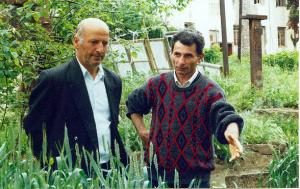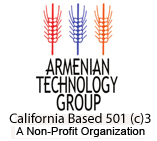Shamshadin -- Key to Armenia
July 7, 2005

For additional photos related to this article, visit the ATG Photo Gallery.
Aygepar, Region of Shamshadin, Armenia — From the balcony of his home, Andranik Hovakimyan pointed past a grove of poplar trees toward the border with neighboring Azerbaijan. “On March 15, 1994, Azeris crossed the border and advanced against our village from two directions,” he said. “After a long battle, our villagers drove them back. As they fled, they left behind several weapons and a tank.” On the second story of his large home, broken windows and a damaged wall bore witness to the attack. “The second time they tried to enter Aygepar, we were ready,” he continued. “They never tried again.”
After the war in Karabagh ended, life in Aygepar returned to normal. Villagers worked in factories in Aygepar and the nearby town of Bert. Shepherds tended their flocks, while farmers cultivated fruit trees, vineyards, and wheat fields. “Before the war, and Soviet collapse, life in Shamshadin was good,” Hovakimyan said. “But, as time passed, our remote region became isolated from advances in other parts of the country. The roads in Shamshadin deteriorated, making commerce difficult. Farmers suffered from a lack of fresh seed, fertilizer, and other items needed for successful harvests of wheat and other grains. Our situation slowly became hopeless.”
The effects of Shamshadin’s isolation had become particularly serious in the grain fields of Aygepar and the neighboring villages of Paravakar, Movses, Ardzvabert, and Chinari. “Our wheat seed was far removed from the Mother Seed, and varieties were mixing with each other,” Hovakimyan said. “People brought us seed, but the quality wasn’t good. In the end, we didn’t trust anyone.”
After a meeting at the office of Crop Production and Plant Cultivation in the Ministry of Agriculture in Yerevan, the situation in Shamshadin soon began to change. At the meeting, Gagik Mkrtchyan, executive director of the Seed Producers’ Support Association (SPSA), an organization founded by the Fresno, California-based Armenian Technology Group (ATG), and department head Garnik Petrosyan discussed SPSA’s work in producing and supplying high quality wheat and barley seed to farmers in outlying areas.
After discussing the economic hardships suffered by Shamshadin Armenians, the men agreed to concentrate new efforts to assist farmers in the region. “After the meeting, Garnik Petrosyan called and suggested I meet Mkrtchyan,” Hovakimyan said. “He told me about the work SPSA was doing. I was impressed with their knowledge and professionalism. They agreed to provide us with a shipment of Bezostaya wheat seed for our autumn planting.”
New seed shipment brings festive atmosphere
On October 14, 2004, a truck loaded with sacks of wheat seed arrived in Aygepar. “The truck had come all the way from Artik, in the province of Shirak,” Hovakimyan said. “From the start, I could see that SPSA was a serious organization.” Farmers from all over Shamshadin gathered in the courtyard of Hovakimyan’s home to purchase the seed. They came by car, truck, jeep, and even on donkeys to take their seed. “One farmer came by donkey all the way from Paravakar, some 30 kilometers from here, and another came from Ardzvashen, a mountain village located directly on the border,” he said. Curious passers-by added to the crowd.
As the truck was unloaded, SPSA professionals Gagik Mkrtchyan, Armen Asatryan, and Vaghinak Kamrastyan carefully weighed every sack, making sure each farmer received the correct amount of seed. Several sacks were opened to check for quality. “The farmers were all amazed,” Hovakimyan said. “Some hadn’t seen seed that good in years. Right away, those who hadn’t placed orders requested seed for themselves. Another 10 metric tons was ordered that day.”
Hovakimyan and the SPSA team went to work. In Hovakimyan’s yard, they prepared a 24-square-meter plot to plant several varieties of winter wheat and barley, to see which of the varieties would prove successful in the unique climate of Shamshadin. In larger plots, they planted Elite wheat and barley seed, to be able to provide farmers with high quality first-generation seed grown in the area. “From the start, our relationship was good,” Hovakimyan said. “Up to the time of the first snowfall, Gagik and the others came to check the progress of the newly-planted wheat and barley. I had never seen this kind of dedication.”
Spring brings new hope, energy to Shamshadin
Spring 2005 blossomed in Shamshadin. Meadows, forests, and fields were green after welcome rains soaked the area. In wheat fields, newly sprouted leaves glistened in the bright sunlight. Walking through vineyard rows on a hill overlooking a field of Bezostaya wheat, Hovakimyan stopped and looked at the new canes, still wet from the previous night’s rain. “I expect a good crop this year,” he said. “After making wine, I’ll sell the remainder of the harvest to the winery in Aygepar.” He walked into the wheat field with Gagik Mkrtchyan and Vaghinak Kamrastyan, who had just arrived in the village. “Last spring, this same field had mixed varieties, and the harvest was very low,” Hovakimyan said. “Now, the new planting of Bezostaya looks perfect.”
Hovakimyan pointed at an open, grassy field in a flat area below. “That farmer should have already cultivated his land for the autumn sowing,” he said. “If he waits too long, the weeds will become a problem.” Kneeling, Kamrastyan pulled a stray weed. “This kind of weed winds around the wheat plant, causing it to lie down,” he said. “If there are more, we can pull them out by hand.”
After leaving the field, the men drove to another where several varieties of wheat, including Stevens, Dadash, Bezostaya, and Findley were planted. “The plot of Stevens looks excellent,” Mkrtchyan said. “It’s a great variety. From Ararat to Lori, ATG farmers plant Stevens. The harvests are high, and the husks are covered with strands that protect the plant from birds.” An old woman walked past the field, towards a small vegetable patch up the hill. In the distance, a car wound its way down a dirt road from Movses village, where farmers also had plantings of the seed brought by SPSA. “Most of the young men from Movses have gone to Russia to work,” Hovakimyan said. “Now, everyone there, as in all of Shamshadin, is waiting for the year’s harvest. The new wheat seed could save our area, our farmers.”
Back at Hovakimyan’s home, the men checked the growth of each variety in the small experimental plot. “Most of the varieties look very good,” Mkrtchyan said. “Especially Stevens, Baldasar, a French variety, and ATGF 35-16. Promontory has a little rust, probably because of the damp climate here.” Valodya Machkalyan, a wheat farmer from nearby Tovuz village and a friend of Hovakimyan, joined the men as they investigated the plot. “Almost every day, area farmers come to see how the new varieties are growing,” Hovakimyan said. His satisfaction was evident. “Sometimes, I see cars parked along the sides of my fields, and people checking the progress of my wheat.
“I feel I’m doing my part for Shamshadin. Our work with SPSA stands to help our farmers tremendously. The advice they give about new varieties and new technologies, such as non-till cultivation, could save us money and make us competitive in the Armenian marketplace. We appreciate everything they are doing for us. Farmers here are excited about the coming harvest. Not one farmer is dissatisfied with the new seed. After harvest, I expect every wheat farmer in Shamshadin to plant SPSA seed. We all want our relationship to continue. If our farmers have good seed, they will stay in Shamshadin. Now, word has even reached Davit Lokyan (Minister of Agriculture) about our wheat. He wants to come to Shamshadin and see our fields for himself.
“To me, bread is life. If we have bread, we are secure, and our life is good.”
For more information about how you can help Armenia’s farmers, contact the ATG office at (559) 224-1000 or by e-mail (info@atgusa.org). Tax-deductible donations can be sent to ATG; 1300 E. Shaw, Suite 149; P.O.Box 5969; Fresno, CA 93755-5969.
You may also donate to ATG online.

Follow Us